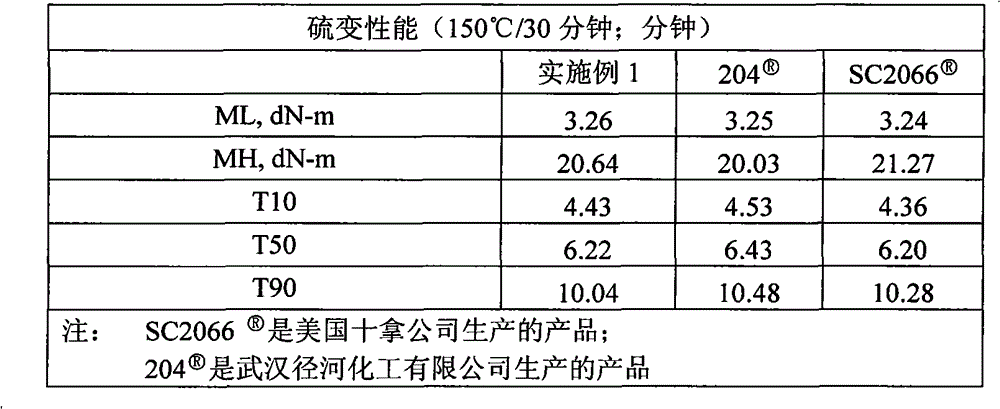Modified alkylphenol-phenolic resin for rubber tackifier and preparation method thereof
A phenolic resin, alkylphenol technology, applied in the direction of adhesives, adhesive types, aldehyde/ketone condensation polymer adhesives, etc., can solve the problems of difficult to realize industrialization, long reaction time, high reaction temperature, and achieve industrialization , environmental protection, simple process effect
- Summary
- Abstract
- Description
- Claims
- Application Information
AI Technical Summary
Problems solved by technology
Method used
Image
Examples
Embodiment 1
[0035] Into a 500ml four-neck round bottom reaction flask equipped with a mechanical stirrer, thermometer, reflux condenser and dropping funnel, 150g (1.0 mole) p-tert-butylphenol and 0.25g dodecylbenzenesulfonic acid (catalyst ), heat the mixture to 80°C to 120°C. When the temperature was 105° C., 33.2 g (0.41 mol) of aqueous formaldehyde solution was added dropwise. After the dropwise addition of the aqueous formaldehyde solution was completed, 10 g of xylene was added, and the reaction was kept under reflux for 10 minutes. Continue to add 22.1g (0.27mol) formaldehyde aqueous solution and reflux for 30 minutes. Then the condenser was changed from the reflux state to the distillation state, and the temperature of the reactants was heated to 130°C to 135°C. After stirring and reacting at this temperature for 1 hour, the temperature was raised to 180°C. Then add 0.12g of 1,8-diazabicyclo-bicyclo(5,4,0)-7-undecene (DBU) neutralization catalyst, stir the reaction for 15 minutes, ...
Embodiment 2
[0037] Into a 500ml four-necked round-bottomed reaction flask equipped with a mechanical stirrer, thermometer, reflux condenser and dropping funnel, 150g (1.0 mole) p-tert-butylphenol and 0.30g dodecylbenzenesulfonic acid (catalyst ), heat the mixture to 80°C to 120°C. When the temperature was 95° C., 54.8 g (0.68 mol) of aqueous formaldehyde solution was added dropwise. After the dropwise addition of the aqueous formaldehyde solution was completed, 80 g of xylene was added, and the reaction was kept under reflux for 10 minutes. Continue to add 18.1 g (0.22 mol) formaldehyde aqueous solution, and react under reflux for 30 minutes. Then the condenser was changed from the reflux state to the distillation state, and the temperature of the reactants was heated to 130°C to 135°C. After stirring and reacting at this temperature for 1 hour, the temperature was raised to 190°C. Then, 1.47g of 2.5% NaOH aqueous solution was added to neutralize the catalyst. After stirring and reacting ...
Embodiment 3
[0039] Into a 500ml four-neck round bottom reaction flask equipped with a mechanical stirrer, thermometer, reflux condenser and dropping funnel, add 150g (1.0 mole) p-tert-butylphenol and 0.15g p-toluenesulfonic acid (catalyst), and heat Mix the mixture to 80°C ~ 120°C. When the temperature was 100° C., 46.2 g (0.57 mol) of aqueous formaldehyde solution was added dropwise. After the dropwise addition of the aqueous formaldehyde solution was completed, 45 g of xylene was added, and the reaction was kept under reflux for 10 minutes. Continue to add 5.6 g (0.17 mol) of paraformaldehyde, and react under reflux for 30 minutes. Then the condenser was changed from the reflux state to the distillation state, and the temperature of the reactants was heated to 130°C to 135°C. After stirring and reacting at this temperature for 1 hour, the temperature was raised to 190°C. Then, 1.26g of 2.5% NaOH aqueous solution was added to neutralize the catalyst. After stirring and reacting for 15 mi...
PUM
| Property | Measurement | Unit |
|---|---|---|
| softening point | aaaaa | aaaaa |
| softening point | aaaaa | aaaaa |
| softening point | aaaaa | aaaaa |
Abstract
Description
Claims
Application Information
 Login to View More
Login to View More - R&D
- Intellectual Property
- Life Sciences
- Materials
- Tech Scout
- Unparalleled Data Quality
- Higher Quality Content
- 60% Fewer Hallucinations
Browse by: Latest US Patents, China's latest patents, Technical Efficacy Thesaurus, Application Domain, Technology Topic, Popular Technical Reports.
© 2025 PatSnap. All rights reserved.Legal|Privacy policy|Modern Slavery Act Transparency Statement|Sitemap|About US| Contact US: help@patsnap.com



